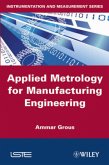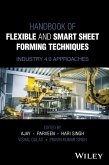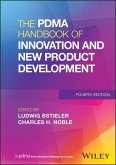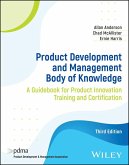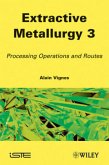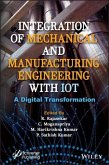Mikell P. Groover
Introduction to Manufacturing Processes
Mikell P. Groover
Introduction to Manufacturing Processes
- Broschiertes Buch
- Merkliste
- Auf die Merkliste
- Bewerten Bewerten
- Teilen
- Produkt teilen
- Produkterinnerung
- Produkterinnerung
Michele Groover's first issue of Manufacturing Processes builds upon much of the content from his 4th edition, of Fundamentals of Modern Manufacturing. The text incorporates design topics, balance quantitative and qualitative coverage; offers most current information on latest developments in the field; and makes the topic of manufacturing processes exciting with visualizing processes.
The text also includes several case studies expanded upon online with related assessment content along with videos with related assessment questions. The text includes "hot topics" pedagogical elements with…mehr
Andere Kunden interessierten sich auch für
![Applied Metrology for Manufacturing Engineering Applied Metrology for Manufacturing Engineering]() Ammar GrousApplied Metrology for Manufacturing Engineering347,99 €
Ammar GrousApplied Metrology for Manufacturing Engineering347,99 €![Handbook of Flexible and Smart Sheet Forming Techniques Handbook of Flexible and Smart Sheet Forming Techniques]() Handbook of Flexible and Smart Sheet Forming Techniques136,99 €
Handbook of Flexible and Smart Sheet Forming Techniques136,99 €![The Pdma Handbook of Innovation and New Product Development The Pdma Handbook of Innovation and New Product Development]() The Pdma Handbook of Innovation and New Product Development129,99 €
The Pdma Handbook of Innovation and New Product Development129,99 €![Product Development and Management Body of Knowledge Product Development and Management Body of Knowledge]() Allan AndersonProduct Development and Management Body of Knowledge59,99 €
Allan AndersonProduct Development and Management Body of Knowledge59,99 €![Smart Digital Manufacturing Smart Digital Manufacturing]() Subba RaoSmart Digital Manufacturing19,99 €
Subba RaoSmart Digital Manufacturing19,99 €![Extractive Metallurgy 3 Extractive Metallurgy 3]() Alain VignesExtractive Metallurgy 3174,99 €
Alain VignesExtractive Metallurgy 3174,99 €![Integration of Mechanical and Manufacturing Engineering with Iot Integration of Mechanical and Manufacturing Engineering with Iot]() Integration of Mechanical and Manufacturing Engineering with Iot186,99 €
Integration of Mechanical and Manufacturing Engineering with Iot186,99 €-
-
-
Michele Groover's first issue of Manufacturing Processes builds upon much of the content from his 4th edition, of Fundamentals of Modern Manufacturing. The text incorporates design topics, balance quantitative and qualitative coverage; offers most current information on latest developments in the field; and makes the topic of manufacturing processes exciting with visualizing processes.
The text also includes several case studies expanded upon online with related assessment content along with videos with related assessment questions. The text includes "hot topics" pedagogical elements with discussions ranging from lean manufacturing to green engineering to nanotechnology as well as an end chapter containing "putting it all together" systems analysis type exercises.
The text also includes several case studies expanded upon online with related assessment content along with videos with related assessment questions. The text includes "hot topics" pedagogical elements with discussions ranging from lean manufacturing to green engineering to nanotechnology as well as an end chapter containing "putting it all together" systems analysis type exercises.
Produktdetails
- Produktdetails
- Verlag: Wiley & Sons
- 1. Auflage
- Seitenzahl: 720
- Erscheinungstermin: 11. Oktober 2011
- Englisch
- Abmessung: 251mm x 203mm x 28mm
- Gewicht: 1205g
- ISBN-13: 9780470632284
- ISBN-10: 0470632283
- Artikelnr.: 33255954
- Herstellerkennzeichnung
- Libri GmbH
- Europaallee 1
- 36244 Bad Hersfeld
- gpsr@libri.de
- Verlag: Wiley & Sons
- 1. Auflage
- Seitenzahl: 720
- Erscheinungstermin: 11. Oktober 2011
- Englisch
- Abmessung: 251mm x 203mm x 28mm
- Gewicht: 1205g
- ISBN-13: 9780470632284
- ISBN-10: 0470632283
- Artikelnr.: 33255954
- Herstellerkennzeichnung
- Libri GmbH
- Europaallee 1
- 36244 Bad Hersfeld
- gpsr@libri.de
Mikell P. Groover is Professor of Industrial and Manufacturing Systems Engineering at Lehigh University, where he also serves as Director of the Manufacturing Technology Laboratory. He holds the following degrees all from Lehigh: B.A. (1961) in Arts and Science, B.S. (1962) in Mechanical Engineering, M.S. (1966) and Ph.D. (1969) in Industrial Engineering. He is a Registered Professional Engineer in Pennsylvania (since 1972). His industrial experience includes full-time employment at Eastman Kodak Company as a Manufacturing Engineer. Since joining Lehigh, he has done consulting, research, and project work for a number of industrial companies including Ingersoll-Rand, Air Products & Chemicals, Bethlehem Steel, and Hershey Foods.
1 INTRODUCTION AND OVERVIEW OF MANUFACTURING.
1.1 What Is Manufacturing?
1.2 Manufacturing Processes.
1.3 Organization of the Book.
Part I Engineering Materials and Product Attributes.
2 ENGINEERING MATERIALS.
2.1 Metals and Their Alloys.
2.2 Ceramics.
Groover: Introduction to Manufacturing Processes.
2.3 Polymers.
2.4 Composites.
3 PROPERTIES OF ENGINEERING MATERIALS.
3.1 Stress-Strain Relationships.
3.2 Hardness.
3.3 Effect of Temperature on Mechanical Properties.
3.4 Fluid Properties.
3.5 Viscoelastic Behavior of Polymers.
3.6 Volumetric and Melting Properties.
3.7 Thermal Properties.
Groover: Introduction to Manufacturing Processes.
4 DIMENSIONS, TOLERANCES AND SURFACES.
4.1 Dimensions, Tolerances, and Related Attributes.
4.2 Surfaces.
4.3 Effect of Manufacturing Processes.
Appendix A4 Measurement of Dimensions and Surfaces.
A4.1 Conventional Measuring Instruments and Gages.
A4.2 Measurement of Surfaces.
Part II Solidification Processes.
5 FUNDAMENTALS OF METAL CASTING.
5.1 Overview of Casting Technology.
Groover: Introduction to Manufacturing Processes.
5.2 Heating and Pouring.
5.3 Solidification and Cooling.
6 METAL CASTING PROCESSES.
6.1 Sand Casting.
6.2 Other Expendable-Mold Casting Processes.
6.3 Permanent-Mold Casting Processes.
Groover: Introduction to Manufacturing Processes.
6.4 Foundry Practice.
6.5 Casting Quality.
6.6 Metals for Casting.
6.7 Product Design Considerations.
7 GLASSWORKING.
7.1 Raw Materials Preparation and Melting.
7.2 Shaping Processes in Glassworking.
7.3 Heat Treatment and Finishing.
7.4 Product Design Considerations.
8 SHAPING PROCESSES FOR PLASTICS.
8.1 Properties of Polymer Melts.
Groover: Introduction to Manufacturing Processes.
8.2 Extrusion.
8.3 Production of Sheet and Film.
8.4 Fiber and Filament Production (Spinning).
8.5 Coating Processes.
8.6 Injection Molding.
8.7 Compression and Transfer Molding.
8.8 Blow Molding and Rotational Molding.
8.9 Thermoforming.
8.10 Casting.
8.11 Polymer Foam Processing and Forming.
8.12 Product Design Considerations.
Groover: Introduction to Manufacturing Processes.
9 SHAPING PROCESSES FOR RUBBER AND POLYMER MATRIX COMPOSITES.
9.1 Rubber Processing and Shaping.
9.2 Manufacture of Tires and Other Rubber Products.
9.3 PMC Shaping Processes and Materials.
9.4 Open Mold Processes.
9.5 Closed Mold Processes.
Groover: Introduction to Manufacturing Processes.
9.6 Filament Winding.
9.7 Pultrusion Processes.
9.8 Other PMC Shaping Processes.
Part III Particulate Processing of Metals and Ceramics.
10 POWDER METALLURGY.
10.1 Production of Metallic Powders.
10.2 Conventional Pressing and Sintering.
10.3 Alternative Pressing and Sintering Techniques.
10.4 Materials and Products for PM.
10.5 Design Considerations in Powder Metallurgy.
Groover: Introduction to Manufacturing Processes.
Appendix 10 Characterization of Engineering Powders.
A10.1 Geometric Features.
A10.2 Other Features.
11 PROCESSING OF CERAMICS AND CERMETS.
11.1 Processing of Traditional Ceramics.
11.2 Processing of New Ceramics.
11.3 Processing of Cermets.
11.4 Product Design Considerations.
Part IV Metal Forming and Sheet Metalworking.
12 FUNDAMENTALS OF METAL FORMING.
12.1 Overview of Metal Forming.
12.2 Material Behavior in Metal Forming.
12.3 Temperature in Metal Forming.
Groover: Introduction to Manufacturing Processes.
12.4 Friction and Lubrication in Metal Forming.
13 BULK DEFORMATION PROCESSES IN METAL WORKING.
13.1 Rolling.
13.2 Forging.
13.3 Extrusion.
13.4 Wire and Bar Drawing.
14 SHEET METALWORKING.
Groover: Introduction to Manufacturing Processes.
14.1 Cutting Operations.
14.2 Bending Operations.
14.3 Drawing.
14.4 Other Sheet-Metal-Forming Operations.
14.5 Dies and Presses for Sheet-Metal Processes.
14.6 Sheet-Metal Operations Not Performed on Presses.
Groover: Introduction to Manufacturing Processes.
Part V Material Removal Processes.
15 THEORY OF METAL MACHINING.
15.1 Overview of Machining Technology.
15.2 Theory of Chip Formation in Metal Machining.
15.3 Force Relationships and the Merchant Equation.
15.4 Power and Energy Relationships in Machining.
15.5 Cutting Temperature.
16 MACHINING OPERATIONS AND MACHINE TOOLS.
16.1 Machining and Part Geometry.
16.2 Turning and Related Operations.
16.3 Drilling and Related Operations.
Groover: Introduction to Manufacturing Processes.
16.4 Milling.
16.5 Machining Centers and Turning Centers.
16.6 Other Machining Operations.
16.7 High-Speed Machining.
16.8 Tolerances and Surface Finish.
16.9 Product Design Considerations in Machining.
17 CUTTING-TOOL TECHNOLOGY AND RELATED TOPICS.
17.1 Tool Life.
17.2 Tool Materials.
Groover: Introduction to Manufacturing Processes.
17.3 Tool Geometry.
17.4 Cutting Fluids.
17.5 Machinability.
17.6 Machining Economics.
18 GRINDING AND OTHER ABRASIVE PROCESSES.
18.1 Grinding.
18.2 Related Abrasive Processes.
Groover: Introduction to Manufacturing Processes.
19 NONTRADITIONAL MACHINING PROCESSES.
19.1 Mechanical Energy Processes.
19.2 Electrochemical Machining Processes.
19.3 Thermal Energy Processes.
19.4 Chemical Machining.
19.5 Application Considerations.
Part VI Property Enhancing and Surface Processing Operations.
20 HEAT TREATMENT OF METALS.
20.1 Annealing.
20.2 Martensite Formation in Steel.
Groover: Introduction to Manufacturing Processes.
20.3 Precipitation Hardening.
20.4 Surface Hardening.
21 SURFACE PROCESSING OPERATIONS.
21.1 Industrial Cleaning Processes.
21.2 Diffusion and Ion Implantation.
21.3 Plating and Related Processes.
21.4 Conversion Coating.
21.5 Vapor Deposition Processes.
21.6 Organic Coatings.
Groover: Introduction to Manufacturing Processes.
Part VII Joining and Assembly Processes
22 FUNDAMENTALS OF WELDING.
22.1 Overview of Welding Technology.
22.2 The Weld Joint.
22.3 Physics of Welding.
22.4 Features of a Fusion-Welded Joint.
23 WELDING PROCESSES.
23.1 Arc Welding.
23.2 Resistance Welding.
23.3 Oxyfuel Gas Welding.
Groover: Introduction to Manufacturing Processes.
23.4 Other Fusion-Welding Processes.
23.5 Solid-State Welding.
23.6 Weld Quality.
23.7 Design Considerations in Welding.
24 BRAZING, SOLDERING, AND ADHESIVE BONDING.
24.1 Brazing.
24.2 Soldering.
24.3 Adhesive Bonding.
25 MECHANICAL ASSEMBLY.
25.1 Threaded Fasteners.
Groover: Introduction to Manufacturing Processes.
25.2 Rivets and Eyelets.
25.3 Assembly Methods Based on Interference Fits.
25.4 Other Mechanical Fastening Methods.
25.5 Molding Inserts and Integral Fasteners.
25.6 Design for Assembly.
Part VIII Special Processing and Assembly Technologies.
26 RAPID PROTOTYPING.
26.1 Fundamentals of Rapid Prototyping.
26.2 Rapid Prototyping Technologies.
26.3 Application Issues in Rapid Prototyping.
27 MICROFABRICATION AND NANOFABRICATION TECHNOLOGIES.
27.1 Microsystem Products.
Groover: Introduction to Manufacturing Processes.
27.2 Microfabrication Processes.
27.3 Nanotechnology Products.
27.4 Scanning Probe Microscopes.
27.5 Nanofabrication Processes.
Part IX Systems Topics in Manufacturing.
28 PRODUCTION SYSTEMS AND PROCESS PLANNING.
28.1 Overview of Production Systems.
28.2 Process Planning.
28.3 Concurrent Engineering and Design for Manufacturability.
29 SURVEY OF AUTOMATION AND MANUFACTURING SYSTEMS.
Groover: Introduction to Manufacturing Processes.
29.1 Computer Numerical Control.
29.2 Cellular Manufacturing.
29.3 Flexible Manufacturing Systems and Cells.
29.4 Lean Production.
29.5 Computer Integrated Manufacturing.
30 QUALITY CONTROL AND INSPECTION.
30.1 Product Quality.
30.2 Process Capability and Tolerances.
30.3 Statistical Process Control.
30.4 Quality Programs in Manufacturing.
Groover: Introduction to Manufacturing Processes.
30.5 Inspection Principles.
30.6 Modern Inspection Technologies.
1.1 What Is Manufacturing?
1.2 Manufacturing Processes.
1.3 Organization of the Book.
Part I Engineering Materials and Product Attributes.
2 ENGINEERING MATERIALS.
2.1 Metals and Their Alloys.
2.2 Ceramics.
Groover: Introduction to Manufacturing Processes.
2.3 Polymers.
2.4 Composites.
3 PROPERTIES OF ENGINEERING MATERIALS.
3.1 Stress-Strain Relationships.
3.2 Hardness.
3.3 Effect of Temperature on Mechanical Properties.
3.4 Fluid Properties.
3.5 Viscoelastic Behavior of Polymers.
3.6 Volumetric and Melting Properties.
3.7 Thermal Properties.
Groover: Introduction to Manufacturing Processes.
4 DIMENSIONS, TOLERANCES AND SURFACES.
4.1 Dimensions, Tolerances, and Related Attributes.
4.2 Surfaces.
4.3 Effect of Manufacturing Processes.
Appendix A4 Measurement of Dimensions and Surfaces.
A4.1 Conventional Measuring Instruments and Gages.
A4.2 Measurement of Surfaces.
Part II Solidification Processes.
5 FUNDAMENTALS OF METAL CASTING.
5.1 Overview of Casting Technology.
Groover: Introduction to Manufacturing Processes.
5.2 Heating and Pouring.
5.3 Solidification and Cooling.
6 METAL CASTING PROCESSES.
6.1 Sand Casting.
6.2 Other Expendable-Mold Casting Processes.
6.3 Permanent-Mold Casting Processes.
Groover: Introduction to Manufacturing Processes.
6.4 Foundry Practice.
6.5 Casting Quality.
6.6 Metals for Casting.
6.7 Product Design Considerations.
7 GLASSWORKING.
7.1 Raw Materials Preparation and Melting.
7.2 Shaping Processes in Glassworking.
7.3 Heat Treatment and Finishing.
7.4 Product Design Considerations.
8 SHAPING PROCESSES FOR PLASTICS.
8.1 Properties of Polymer Melts.
Groover: Introduction to Manufacturing Processes.
8.2 Extrusion.
8.3 Production of Sheet and Film.
8.4 Fiber and Filament Production (Spinning).
8.5 Coating Processes.
8.6 Injection Molding.
8.7 Compression and Transfer Molding.
8.8 Blow Molding and Rotational Molding.
8.9 Thermoforming.
8.10 Casting.
8.11 Polymer Foam Processing and Forming.
8.12 Product Design Considerations.
Groover: Introduction to Manufacturing Processes.
9 SHAPING PROCESSES FOR RUBBER AND POLYMER MATRIX COMPOSITES.
9.1 Rubber Processing and Shaping.
9.2 Manufacture of Tires and Other Rubber Products.
9.3 PMC Shaping Processes and Materials.
9.4 Open Mold Processes.
9.5 Closed Mold Processes.
Groover: Introduction to Manufacturing Processes.
9.6 Filament Winding.
9.7 Pultrusion Processes.
9.8 Other PMC Shaping Processes.
Part III Particulate Processing of Metals and Ceramics.
10 POWDER METALLURGY.
10.1 Production of Metallic Powders.
10.2 Conventional Pressing and Sintering.
10.3 Alternative Pressing and Sintering Techniques.
10.4 Materials and Products for PM.
10.5 Design Considerations in Powder Metallurgy.
Groover: Introduction to Manufacturing Processes.
Appendix 10 Characterization of Engineering Powders.
A10.1 Geometric Features.
A10.2 Other Features.
11 PROCESSING OF CERAMICS AND CERMETS.
11.1 Processing of Traditional Ceramics.
11.2 Processing of New Ceramics.
11.3 Processing of Cermets.
11.4 Product Design Considerations.
Part IV Metal Forming and Sheet Metalworking.
12 FUNDAMENTALS OF METAL FORMING.
12.1 Overview of Metal Forming.
12.2 Material Behavior in Metal Forming.
12.3 Temperature in Metal Forming.
Groover: Introduction to Manufacturing Processes.
12.4 Friction and Lubrication in Metal Forming.
13 BULK DEFORMATION PROCESSES IN METAL WORKING.
13.1 Rolling.
13.2 Forging.
13.3 Extrusion.
13.4 Wire and Bar Drawing.
14 SHEET METALWORKING.
Groover: Introduction to Manufacturing Processes.
14.1 Cutting Operations.
14.2 Bending Operations.
14.3 Drawing.
14.4 Other Sheet-Metal-Forming Operations.
14.5 Dies and Presses for Sheet-Metal Processes.
14.6 Sheet-Metal Operations Not Performed on Presses.
Groover: Introduction to Manufacturing Processes.
Part V Material Removal Processes.
15 THEORY OF METAL MACHINING.
15.1 Overview of Machining Technology.
15.2 Theory of Chip Formation in Metal Machining.
15.3 Force Relationships and the Merchant Equation.
15.4 Power and Energy Relationships in Machining.
15.5 Cutting Temperature.
16 MACHINING OPERATIONS AND MACHINE TOOLS.
16.1 Machining and Part Geometry.
16.2 Turning and Related Operations.
16.3 Drilling and Related Operations.
Groover: Introduction to Manufacturing Processes.
16.4 Milling.
16.5 Machining Centers and Turning Centers.
16.6 Other Machining Operations.
16.7 High-Speed Machining.
16.8 Tolerances and Surface Finish.
16.9 Product Design Considerations in Machining.
17 CUTTING-TOOL TECHNOLOGY AND RELATED TOPICS.
17.1 Tool Life.
17.2 Tool Materials.
Groover: Introduction to Manufacturing Processes.
17.3 Tool Geometry.
17.4 Cutting Fluids.
17.5 Machinability.
17.6 Machining Economics.
18 GRINDING AND OTHER ABRASIVE PROCESSES.
18.1 Grinding.
18.2 Related Abrasive Processes.
Groover: Introduction to Manufacturing Processes.
19 NONTRADITIONAL MACHINING PROCESSES.
19.1 Mechanical Energy Processes.
19.2 Electrochemical Machining Processes.
19.3 Thermal Energy Processes.
19.4 Chemical Machining.
19.5 Application Considerations.
Part VI Property Enhancing and Surface Processing Operations.
20 HEAT TREATMENT OF METALS.
20.1 Annealing.
20.2 Martensite Formation in Steel.
Groover: Introduction to Manufacturing Processes.
20.3 Precipitation Hardening.
20.4 Surface Hardening.
21 SURFACE PROCESSING OPERATIONS.
21.1 Industrial Cleaning Processes.
21.2 Diffusion and Ion Implantation.
21.3 Plating and Related Processes.
21.4 Conversion Coating.
21.5 Vapor Deposition Processes.
21.6 Organic Coatings.
Groover: Introduction to Manufacturing Processes.
Part VII Joining and Assembly Processes
22 FUNDAMENTALS OF WELDING.
22.1 Overview of Welding Technology.
22.2 The Weld Joint.
22.3 Physics of Welding.
22.4 Features of a Fusion-Welded Joint.
23 WELDING PROCESSES.
23.1 Arc Welding.
23.2 Resistance Welding.
23.3 Oxyfuel Gas Welding.
Groover: Introduction to Manufacturing Processes.
23.4 Other Fusion-Welding Processes.
23.5 Solid-State Welding.
23.6 Weld Quality.
23.7 Design Considerations in Welding.
24 BRAZING, SOLDERING, AND ADHESIVE BONDING.
24.1 Brazing.
24.2 Soldering.
24.3 Adhesive Bonding.
25 MECHANICAL ASSEMBLY.
25.1 Threaded Fasteners.
Groover: Introduction to Manufacturing Processes.
25.2 Rivets and Eyelets.
25.3 Assembly Methods Based on Interference Fits.
25.4 Other Mechanical Fastening Methods.
25.5 Molding Inserts and Integral Fasteners.
25.6 Design for Assembly.
Part VIII Special Processing and Assembly Technologies.
26 RAPID PROTOTYPING.
26.1 Fundamentals of Rapid Prototyping.
26.2 Rapid Prototyping Technologies.
26.3 Application Issues in Rapid Prototyping.
27 MICROFABRICATION AND NANOFABRICATION TECHNOLOGIES.
27.1 Microsystem Products.
Groover: Introduction to Manufacturing Processes.
27.2 Microfabrication Processes.
27.3 Nanotechnology Products.
27.4 Scanning Probe Microscopes.
27.5 Nanofabrication Processes.
Part IX Systems Topics in Manufacturing.
28 PRODUCTION SYSTEMS AND PROCESS PLANNING.
28.1 Overview of Production Systems.
28.2 Process Planning.
28.3 Concurrent Engineering and Design for Manufacturability.
29 SURVEY OF AUTOMATION AND MANUFACTURING SYSTEMS.
Groover: Introduction to Manufacturing Processes.
29.1 Computer Numerical Control.
29.2 Cellular Manufacturing.
29.3 Flexible Manufacturing Systems and Cells.
29.4 Lean Production.
29.5 Computer Integrated Manufacturing.
30 QUALITY CONTROL AND INSPECTION.
30.1 Product Quality.
30.2 Process Capability and Tolerances.
30.3 Statistical Process Control.
30.4 Quality Programs in Manufacturing.
Groover: Introduction to Manufacturing Processes.
30.5 Inspection Principles.
30.6 Modern Inspection Technologies.
1 INTRODUCTION AND OVERVIEW OF MANUFACTURING.
1.1 What Is Manufacturing?
1.2 Manufacturing Processes.
1.3 Organization of the Book.
Part I Engineering Materials and Product Attributes.
2 ENGINEERING MATERIALS.
2.1 Metals and Their Alloys.
2.2 Ceramics.
Groover: Introduction to Manufacturing Processes.
2.3 Polymers.
2.4 Composites.
3 PROPERTIES OF ENGINEERING MATERIALS.
3.1 Stress-Strain Relationships.
3.2 Hardness.
3.3 Effect of Temperature on Mechanical Properties.
3.4 Fluid Properties.
3.5 Viscoelastic Behavior of Polymers.
3.6 Volumetric and Melting Properties.
3.7 Thermal Properties.
Groover: Introduction to Manufacturing Processes.
4 DIMENSIONS, TOLERANCES AND SURFACES.
4.1 Dimensions, Tolerances, and Related Attributes.
4.2 Surfaces.
4.3 Effect of Manufacturing Processes.
Appendix A4 Measurement of Dimensions and Surfaces.
A4.1 Conventional Measuring Instruments and Gages.
A4.2 Measurement of Surfaces.
Part II Solidification Processes.
5 FUNDAMENTALS OF METAL CASTING.
5.1 Overview of Casting Technology.
Groover: Introduction to Manufacturing Processes.
5.2 Heating and Pouring.
5.3 Solidification and Cooling.
6 METAL CASTING PROCESSES.
6.1 Sand Casting.
6.2 Other Expendable-Mold Casting Processes.
6.3 Permanent-Mold Casting Processes.
Groover: Introduction to Manufacturing Processes.
6.4 Foundry Practice.
6.5 Casting Quality.
6.6 Metals for Casting.
6.7 Product Design Considerations.
7 GLASSWORKING.
7.1 Raw Materials Preparation and Melting.
7.2 Shaping Processes in Glassworking.
7.3 Heat Treatment and Finishing.
7.4 Product Design Considerations.
8 SHAPING PROCESSES FOR PLASTICS.
8.1 Properties of Polymer Melts.
Groover: Introduction to Manufacturing Processes.
8.2 Extrusion.
8.3 Production of Sheet and Film.
8.4 Fiber and Filament Production (Spinning).
8.5 Coating Processes.
8.6 Injection Molding.
8.7 Compression and Transfer Molding.
8.8 Blow Molding and Rotational Molding.
8.9 Thermoforming.
8.10 Casting.
8.11 Polymer Foam Processing and Forming.
8.12 Product Design Considerations.
Groover: Introduction to Manufacturing Processes.
9 SHAPING PROCESSES FOR RUBBER AND POLYMER MATRIX COMPOSITES.
9.1 Rubber Processing and Shaping.
9.2 Manufacture of Tires and Other Rubber Products.
9.3 PMC Shaping Processes and Materials.
9.4 Open Mold Processes.
9.5 Closed Mold Processes.
Groover: Introduction to Manufacturing Processes.
9.6 Filament Winding.
9.7 Pultrusion Processes.
9.8 Other PMC Shaping Processes.
Part III Particulate Processing of Metals and Ceramics.
10 POWDER METALLURGY.
10.1 Production of Metallic Powders.
10.2 Conventional Pressing and Sintering.
10.3 Alternative Pressing and Sintering Techniques.
10.4 Materials and Products for PM.
10.5 Design Considerations in Powder Metallurgy.
Groover: Introduction to Manufacturing Processes.
Appendix 10 Characterization of Engineering Powders.
A10.1 Geometric Features.
A10.2 Other Features.
11 PROCESSING OF CERAMICS AND CERMETS.
11.1 Processing of Traditional Ceramics.
11.2 Processing of New Ceramics.
11.3 Processing of Cermets.
11.4 Product Design Considerations.
Part IV Metal Forming and Sheet Metalworking.
12 FUNDAMENTALS OF METAL FORMING.
12.1 Overview of Metal Forming.
12.2 Material Behavior in Metal Forming.
12.3 Temperature in Metal Forming.
Groover: Introduction to Manufacturing Processes.
12.4 Friction and Lubrication in Metal Forming.
13 BULK DEFORMATION PROCESSES IN METAL WORKING.
13.1 Rolling.
13.2 Forging.
13.3 Extrusion.
13.4 Wire and Bar Drawing.
14 SHEET METALWORKING.
Groover: Introduction to Manufacturing Processes.
14.1 Cutting Operations.
14.2 Bending Operations.
14.3 Drawing.
14.4 Other Sheet-Metal-Forming Operations.
14.5 Dies and Presses for Sheet-Metal Processes.
14.6 Sheet-Metal Operations Not Performed on Presses.
Groover: Introduction to Manufacturing Processes.
Part V Material Removal Processes.
15 THEORY OF METAL MACHINING.
15.1 Overview of Machining Technology.
15.2 Theory of Chip Formation in Metal Machining.
15.3 Force Relationships and the Merchant Equation.
15.4 Power and Energy Relationships in Machining.
15.5 Cutting Temperature.
16 MACHINING OPERATIONS AND MACHINE TOOLS.
16.1 Machining and Part Geometry.
16.2 Turning and Related Operations.
16.3 Drilling and Related Operations.
Groover: Introduction to Manufacturing Processes.
16.4 Milling.
16.5 Machining Centers and Turning Centers.
16.6 Other Machining Operations.
16.7 High-Speed Machining.
16.8 Tolerances and Surface Finish.
16.9 Product Design Considerations in Machining.
17 CUTTING-TOOL TECHNOLOGY AND RELATED TOPICS.
17.1 Tool Life.
17.2 Tool Materials.
Groover: Introduction to Manufacturing Processes.
17.3 Tool Geometry.
17.4 Cutting Fluids.
17.5 Machinability.
17.6 Machining Economics.
18 GRINDING AND OTHER ABRASIVE PROCESSES.
18.1 Grinding.
18.2 Related Abrasive Processes.
Groover: Introduction to Manufacturing Processes.
19 NONTRADITIONAL MACHINING PROCESSES.
19.1 Mechanical Energy Processes.
19.2 Electrochemical Machining Processes.
19.3 Thermal Energy Processes.
19.4 Chemical Machining.
19.5 Application Considerations.
Part VI Property Enhancing and Surface Processing Operations.
20 HEAT TREATMENT OF METALS.
20.1 Annealing.
20.2 Martensite Formation in Steel.
Groover: Introduction to Manufacturing Processes.
20.3 Precipitation Hardening.
20.4 Surface Hardening.
21 SURFACE PROCESSING OPERATIONS.
21.1 Industrial Cleaning Processes.
21.2 Diffusion and Ion Implantation.
21.3 Plating and Related Processes.
21.4 Conversion Coating.
21.5 Vapor Deposition Processes.
21.6 Organic Coatings.
Groover: Introduction to Manufacturing Processes.
Part VII Joining and Assembly Processes
22 FUNDAMENTALS OF WELDING.
22.1 Overview of Welding Technology.
22.2 The Weld Joint.
22.3 Physics of Welding.
22.4 Features of a Fusion-Welded Joint.
23 WELDING PROCESSES.
23.1 Arc Welding.
23.2 Resistance Welding.
23.3 Oxyfuel Gas Welding.
Groover: Introduction to Manufacturing Processes.
23.4 Other Fusion-Welding Processes.
23.5 Solid-State Welding.
23.6 Weld Quality.
23.7 Design Considerations in Welding.
24 BRAZING, SOLDERING, AND ADHESIVE BONDING.
24.1 Brazing.
24.2 Soldering.
24.3 Adhesive Bonding.
25 MECHANICAL ASSEMBLY.
25.1 Threaded Fasteners.
Groover: Introduction to Manufacturing Processes.
25.2 Rivets and Eyelets.
25.3 Assembly Methods Based on Interference Fits.
25.4 Other Mechanical Fastening Methods.
25.5 Molding Inserts and Integral Fasteners.
25.6 Design for Assembly.
Part VIII Special Processing and Assembly Technologies.
26 RAPID PROTOTYPING.
26.1 Fundamentals of Rapid Prototyping.
26.2 Rapid Prototyping Technologies.
26.3 Application Issues in Rapid Prototyping.
27 MICROFABRICATION AND NANOFABRICATION TECHNOLOGIES.
27.1 Microsystem Products.
Groover: Introduction to Manufacturing Processes.
27.2 Microfabrication Processes.
27.3 Nanotechnology Products.
27.4 Scanning Probe Microscopes.
27.5 Nanofabrication Processes.
Part IX Systems Topics in Manufacturing.
28 PRODUCTION SYSTEMS AND PROCESS PLANNING.
28.1 Overview of Production Systems.
28.2 Process Planning.
28.3 Concurrent Engineering and Design for Manufacturability.
29 SURVEY OF AUTOMATION AND MANUFACTURING SYSTEMS.
Groover: Introduction to Manufacturing Processes.
29.1 Computer Numerical Control.
29.2 Cellular Manufacturing.
29.3 Flexible Manufacturing Systems and Cells.
29.4 Lean Production.
29.5 Computer Integrated Manufacturing.
30 QUALITY CONTROL AND INSPECTION.
30.1 Product Quality.
30.2 Process Capability and Tolerances.
30.3 Statistical Process Control.
30.4 Quality Programs in Manufacturing.
Groover: Introduction to Manufacturing Processes.
30.5 Inspection Principles.
30.6 Modern Inspection Technologies.
1.1 What Is Manufacturing?
1.2 Manufacturing Processes.
1.3 Organization of the Book.
Part I Engineering Materials and Product Attributes.
2 ENGINEERING MATERIALS.
2.1 Metals and Their Alloys.
2.2 Ceramics.
Groover: Introduction to Manufacturing Processes.
2.3 Polymers.
2.4 Composites.
3 PROPERTIES OF ENGINEERING MATERIALS.
3.1 Stress-Strain Relationships.
3.2 Hardness.
3.3 Effect of Temperature on Mechanical Properties.
3.4 Fluid Properties.
3.5 Viscoelastic Behavior of Polymers.
3.6 Volumetric and Melting Properties.
3.7 Thermal Properties.
Groover: Introduction to Manufacturing Processes.
4 DIMENSIONS, TOLERANCES AND SURFACES.
4.1 Dimensions, Tolerances, and Related Attributes.
4.2 Surfaces.
4.3 Effect of Manufacturing Processes.
Appendix A4 Measurement of Dimensions and Surfaces.
A4.1 Conventional Measuring Instruments and Gages.
A4.2 Measurement of Surfaces.
Part II Solidification Processes.
5 FUNDAMENTALS OF METAL CASTING.
5.1 Overview of Casting Technology.
Groover: Introduction to Manufacturing Processes.
5.2 Heating and Pouring.
5.3 Solidification and Cooling.
6 METAL CASTING PROCESSES.
6.1 Sand Casting.
6.2 Other Expendable-Mold Casting Processes.
6.3 Permanent-Mold Casting Processes.
Groover: Introduction to Manufacturing Processes.
6.4 Foundry Practice.
6.5 Casting Quality.
6.6 Metals for Casting.
6.7 Product Design Considerations.
7 GLASSWORKING.
7.1 Raw Materials Preparation and Melting.
7.2 Shaping Processes in Glassworking.
7.3 Heat Treatment and Finishing.
7.4 Product Design Considerations.
8 SHAPING PROCESSES FOR PLASTICS.
8.1 Properties of Polymer Melts.
Groover: Introduction to Manufacturing Processes.
8.2 Extrusion.
8.3 Production of Sheet and Film.
8.4 Fiber and Filament Production (Spinning).
8.5 Coating Processes.
8.6 Injection Molding.
8.7 Compression and Transfer Molding.
8.8 Blow Molding and Rotational Molding.
8.9 Thermoforming.
8.10 Casting.
8.11 Polymer Foam Processing and Forming.
8.12 Product Design Considerations.
Groover: Introduction to Manufacturing Processes.
9 SHAPING PROCESSES FOR RUBBER AND POLYMER MATRIX COMPOSITES.
9.1 Rubber Processing and Shaping.
9.2 Manufacture of Tires and Other Rubber Products.
9.3 PMC Shaping Processes and Materials.
9.4 Open Mold Processes.
9.5 Closed Mold Processes.
Groover: Introduction to Manufacturing Processes.
9.6 Filament Winding.
9.7 Pultrusion Processes.
9.8 Other PMC Shaping Processes.
Part III Particulate Processing of Metals and Ceramics.
10 POWDER METALLURGY.
10.1 Production of Metallic Powders.
10.2 Conventional Pressing and Sintering.
10.3 Alternative Pressing and Sintering Techniques.
10.4 Materials and Products for PM.
10.5 Design Considerations in Powder Metallurgy.
Groover: Introduction to Manufacturing Processes.
Appendix 10 Characterization of Engineering Powders.
A10.1 Geometric Features.
A10.2 Other Features.
11 PROCESSING OF CERAMICS AND CERMETS.
11.1 Processing of Traditional Ceramics.
11.2 Processing of New Ceramics.
11.3 Processing of Cermets.
11.4 Product Design Considerations.
Part IV Metal Forming and Sheet Metalworking.
12 FUNDAMENTALS OF METAL FORMING.
12.1 Overview of Metal Forming.
12.2 Material Behavior in Metal Forming.
12.3 Temperature in Metal Forming.
Groover: Introduction to Manufacturing Processes.
12.4 Friction and Lubrication in Metal Forming.
13 BULK DEFORMATION PROCESSES IN METAL WORKING.
13.1 Rolling.
13.2 Forging.
13.3 Extrusion.
13.4 Wire and Bar Drawing.
14 SHEET METALWORKING.
Groover: Introduction to Manufacturing Processes.
14.1 Cutting Operations.
14.2 Bending Operations.
14.3 Drawing.
14.4 Other Sheet-Metal-Forming Operations.
14.5 Dies and Presses for Sheet-Metal Processes.
14.6 Sheet-Metal Operations Not Performed on Presses.
Groover: Introduction to Manufacturing Processes.
Part V Material Removal Processes.
15 THEORY OF METAL MACHINING.
15.1 Overview of Machining Technology.
15.2 Theory of Chip Formation in Metal Machining.
15.3 Force Relationships and the Merchant Equation.
15.4 Power and Energy Relationships in Machining.
15.5 Cutting Temperature.
16 MACHINING OPERATIONS AND MACHINE TOOLS.
16.1 Machining and Part Geometry.
16.2 Turning and Related Operations.
16.3 Drilling and Related Operations.
Groover: Introduction to Manufacturing Processes.
16.4 Milling.
16.5 Machining Centers and Turning Centers.
16.6 Other Machining Operations.
16.7 High-Speed Machining.
16.8 Tolerances and Surface Finish.
16.9 Product Design Considerations in Machining.
17 CUTTING-TOOL TECHNOLOGY AND RELATED TOPICS.
17.1 Tool Life.
17.2 Tool Materials.
Groover: Introduction to Manufacturing Processes.
17.3 Tool Geometry.
17.4 Cutting Fluids.
17.5 Machinability.
17.6 Machining Economics.
18 GRINDING AND OTHER ABRASIVE PROCESSES.
18.1 Grinding.
18.2 Related Abrasive Processes.
Groover: Introduction to Manufacturing Processes.
19 NONTRADITIONAL MACHINING PROCESSES.
19.1 Mechanical Energy Processes.
19.2 Electrochemical Machining Processes.
19.3 Thermal Energy Processes.
19.4 Chemical Machining.
19.5 Application Considerations.
Part VI Property Enhancing and Surface Processing Operations.
20 HEAT TREATMENT OF METALS.
20.1 Annealing.
20.2 Martensite Formation in Steel.
Groover: Introduction to Manufacturing Processes.
20.3 Precipitation Hardening.
20.4 Surface Hardening.
21 SURFACE PROCESSING OPERATIONS.
21.1 Industrial Cleaning Processes.
21.2 Diffusion and Ion Implantation.
21.3 Plating and Related Processes.
21.4 Conversion Coating.
21.5 Vapor Deposition Processes.
21.6 Organic Coatings.
Groover: Introduction to Manufacturing Processes.
Part VII Joining and Assembly Processes
22 FUNDAMENTALS OF WELDING.
22.1 Overview of Welding Technology.
22.2 The Weld Joint.
22.3 Physics of Welding.
22.4 Features of a Fusion-Welded Joint.
23 WELDING PROCESSES.
23.1 Arc Welding.
23.2 Resistance Welding.
23.3 Oxyfuel Gas Welding.
Groover: Introduction to Manufacturing Processes.
23.4 Other Fusion-Welding Processes.
23.5 Solid-State Welding.
23.6 Weld Quality.
23.7 Design Considerations in Welding.
24 BRAZING, SOLDERING, AND ADHESIVE BONDING.
24.1 Brazing.
24.2 Soldering.
24.3 Adhesive Bonding.
25 MECHANICAL ASSEMBLY.
25.1 Threaded Fasteners.
Groover: Introduction to Manufacturing Processes.
25.2 Rivets and Eyelets.
25.3 Assembly Methods Based on Interference Fits.
25.4 Other Mechanical Fastening Methods.
25.5 Molding Inserts and Integral Fasteners.
25.6 Design for Assembly.
Part VIII Special Processing and Assembly Technologies.
26 RAPID PROTOTYPING.
26.1 Fundamentals of Rapid Prototyping.
26.2 Rapid Prototyping Technologies.
26.3 Application Issues in Rapid Prototyping.
27 MICROFABRICATION AND NANOFABRICATION TECHNOLOGIES.
27.1 Microsystem Products.
Groover: Introduction to Manufacturing Processes.
27.2 Microfabrication Processes.
27.3 Nanotechnology Products.
27.4 Scanning Probe Microscopes.
27.5 Nanofabrication Processes.
Part IX Systems Topics in Manufacturing.
28 PRODUCTION SYSTEMS AND PROCESS PLANNING.
28.1 Overview of Production Systems.
28.2 Process Planning.
28.3 Concurrent Engineering and Design for Manufacturability.
29 SURVEY OF AUTOMATION AND MANUFACTURING SYSTEMS.
Groover: Introduction to Manufacturing Processes.
29.1 Computer Numerical Control.
29.2 Cellular Manufacturing.
29.3 Flexible Manufacturing Systems and Cells.
29.4 Lean Production.
29.5 Computer Integrated Manufacturing.
30 QUALITY CONTROL AND INSPECTION.
30.1 Product Quality.
30.2 Process Capability and Tolerances.
30.3 Statistical Process Control.
30.4 Quality Programs in Manufacturing.
Groover: Introduction to Manufacturing Processes.
30.5 Inspection Principles.
30.6 Modern Inspection Technologies.


